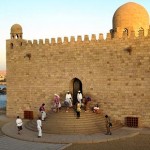
The Valley of the Queens is a place in Egypt where wives of Pharaohs were buried in ancient times. In ancient times, it was known as Ta-Set-Neferu, meaning –‘the place of the Children of the Pharaoh’, because along with the Queens of the 18th, 19th and 20th dynasties (1550–1070 BCE) many princes and princesses were […]

The Valley of the Kings is a valley in Egypt where, for a period of nearly 500 years from the 16th to 11th century BC, tombs were constructed for the Pharaohs and powerful nobles of the New Kingdom (the Eighteenth to the Twentieth Dynasties of Ancient Egypt) The valley stands on the west bank of […]

Hatshepsut (or Hatchepsut, pronounced meaning Foremost of Noble Ladies, (1508–1458 BC) was the fifth pharaoh of the eighteenth dynasty of Ancient Egypt. She is generally regarded by Egyptologists as one of the most successful pharaohs, reigning longer than any other woman of an indigenous Egyptian dynasty. Although poor records of her reign are documented in […]

The Temple of Dendara was known as the ‘Castle of the Sistrum’ or ‘Pr Hathor’ – House of Hathor. Hathor was the goddess of love, joy and beauty. With the exception of its supporting pillars, which had capitals sculpted in the image of Hathor and were defaced by the Christians, the walls, rooms and roof […]

This is the Mausoleum of the spiritual leader of the Ismailis, a Shi’ite sect (as were the Fatimid) based principally in India but with followers around the world. It is a very elegant pink granite structure of late 1950 origin, which also resembles the Fatimid tombs in Cairo. Members of this sect consider themselves to […]

The Abu Simbel temples are two massive rock temples in Abu Simbel in Nubia, southern Egypt. They are situated on the western bank of Lake Nasser, about 230 km southwest of Aswan (about 300 km by road). The complex is part of the UNESCO World Heritage Site known as the “Nubian Monuments,” which run from Abu Simbel […]

The Temple of Kom Ombo is an unusual double temple built during the Ptolemaic dynasty in the Egyptian town of Kom Ombo. Some additions to it were later made during the Roman period. The building is unique because its ‘double’ design meant that there were courts, halls, sanctuaries and rooms duplicated for two sets of […]

The unfinished obelisk is the largest known ancient obelisk, located in the northern region of the stone quarries of ancient Egypt in Aswan (Assuan), Egypt. Archaeologists claim the pharaoh known as Hatshepsut sanctioned it’s construction. It is nearly one third larger than any ancient Egyptian obelisk ever erected. If finished it would have measured around […]

Philae is an island in Lake Nasser, Egypt. It was formerly an island in the First Cataract of the Nile River and the previous site of an Ancient Egyptian temple complex in southern Egypt. The complex was dismantled and relocated to nearby Agilkia Island during a UNESCO project started because of the construction of the […]

Temple of Edfu The Temple of Edfu is an ancient Egyptian temple located on the west bank of the Nile in the city of Edfu which was known in Greco-Roman times as Apollonopolis Magna, after the chief god Horus-Apollo. It is one of the best preserved temples in Egypt. The temple, dedicated to the falcon […]
